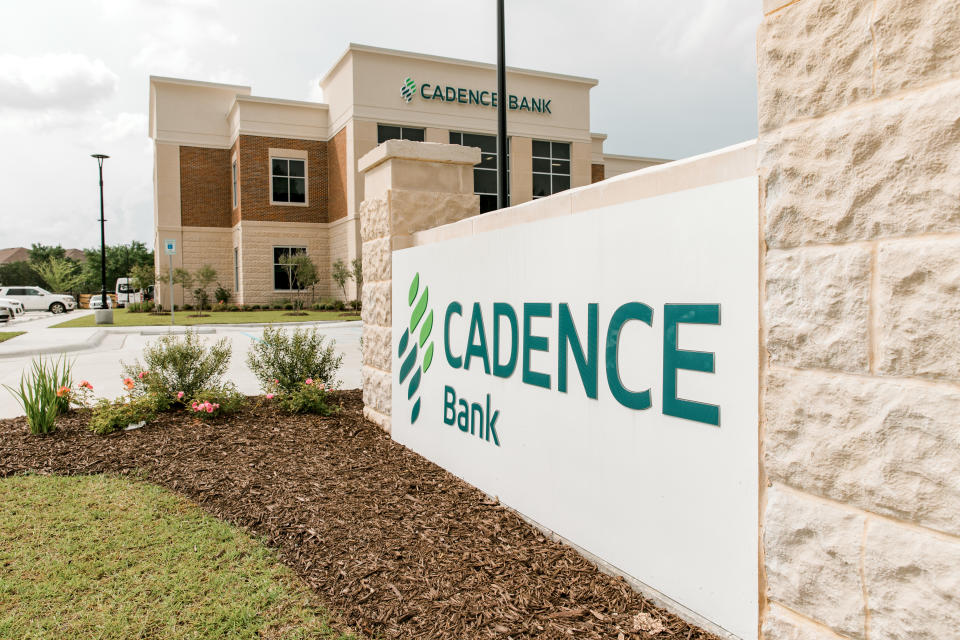Cadence Bank says insurance unit's sale should help capital, efficiency

Cadence Bank is selling its insurance business in a move that the Southeast regional bank says will improve its capital position, increase its efficiency and reward shareholders with higher earnings.
The deal to sell one of the largest bank-owned insurance brokerages in the United States for $904 million in cash is the latest example of banks parting with their highly valued insurance subsidiaries.
The announcement on Tuesday of the unit's sale to global insurance firm Arthur J. Gallagher came about one month after an industry publication reported that Cadence was close to finding a buyer for the business. It was also one month after Arthur J. Gallagher acquired Eastern Bankshares' insurance unit for $510 million in cash.
The divestiture — which is expected to be finalized during the fourth quarter — allows Cadence to take advantage of the current steep valuations of insurance agencies and reinvest the capital in a way that improves its earnings and generates higher shareholder returns, according to Cadence Chairman and CEO Dan Rollins. The sale price is nearly five-and-a-half times the total revenue generated by Cadence Insurance over the past 12 months, he noted.
Rollins was frank Tuesday about his dissatisfaction with certain key financial metrics since the $48.7 billion-asset Cadence was formed in 2021 through the merger of BancorpSouth Bank in Tupelo, Mississippi, and Cadence Bancorp. in Dallas. The combined company's adjusted return on average assets, for instance, has declined for at least five quarters in a row, ending at 0.87% for the third quarter.
Also during the third quarter, Cadence's adjusted efficiency ratio was 66.1%, up from 63.6% three months earlier, and much higher than the estimated 54.4% the post-merger company had hoped to realize by 2022.
"When you look at us and you compare us to what's going on in the market, we're not where we want to be," Rollins told analysts during the company's third-quarter earnings call, held just hours after the insurance unit's sale was announced.
"Nobody is willing to hide from that. We've got to improve, and I think this transaction gives us some tools in our toolkit to allow us to improve."
Cadence Insurance, which is headquartered in Baton Rouge, Louisiana, employs about 770 people in 30 offices across nine states in the Southeast, the company said. It originated as a collection of agencies acquired by BancorpSouth between 1999 and 2003, and was formalized in 2005.
As part of the deal, Cadence Insurance executives, managers and employees will join Arthur J. Gallagher, which will become the preferred insurance brokerage partner of Cadence Bank.
Among large bank-owned insurance brokerages, Cadence Insurance trails Truist Financial's insurance subsidiary in size. Earlier this year, Charlotte, North Carolina-based Truist sold 20% of its stake in Truist Insurance Holdings to a private equity firm for $1.95 billion, a move that Truist executives said would pay for future growth and boost earnings over time.
It remains unclear if Truist will decide to sell another portion or the entire subsidiary, but for now it is holding on to the residual stake as a way to retain strategic and financial "flexibility," Truist CEO Bill Rogers recently told analysts.
Cadence plans to use the proceeds from its sale, which will amount to about $650 million after taxes and other costs such as insurance employee retention and incentives, to repay wholesale borrowings that have an average rate of 5.55%, executives said. The company also plans to restructure its securities portfolio by selling lower-yielding securities and purchasing higher-yielding ones.
"As we look forward, we're committed to improving our performance," Rollins said. "Our planned bond restructuring will obviously be a benefit to us, as the options this transaction provides will allow us to fast forward some of our improvement plans and reward our shareholders."
As part of an effort to improve its performance, Cadence has been trying to reduce its noninterest expenses. During the third quarter, the company closed 35 branches, contributing to a reduction in the total number of offices from 407 at the time of the merger to about 350 today. Cadence also trimmed its workforce by 319 last quarter and expects to cut 80 more jobs during the fourth quarter.
The company is "working hard" to keep 2024 expenses flat, Rollins said.
Analysts were largely upbeat about the insurance unit's sale. Several of them pointed to the fact that Cadence anticipates an 11% increase in earnings per share and a possible resumption of share repurchases.
Another positive factor in the eyes of analysts was the fact that Cadence disclosed how it intends to use the sale's proceeds.
"Our largest unknown with the speculated insurance sale had been what Cadence would do with the proceeds and what the [earnings per share] impact would ultimately be," Piper Sandler analyst Stephen Scouten wrote in a research note. "The message that [earnings per share] will be slightly positive on the use of the $650 million in net cash proceeds is encouraging."
